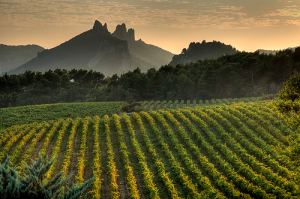For us, the Rhône Valley and its wines carries strong and vivid memories of some of our most delightful wine tasting experiences there. Our first experience with Rhône River Valley vineyards was about 30 years ago when a trip to Grenoble gave us several extra days to spend in Dijon. That was a wonderful way to start our experience, as Dijon is known for having the best food in all of France. Be sure to plan a few days there; our favorite restaurants are from among the myriad of curbside bistros lining the streets. But we digress; on to the subject of wine tasting in the Rhône Valley (which is close to and easily reached from Dijon).
A French friend was our host– and a knowledgeable one at that! We stayed off the beaten path of well-known vineyards and spent our time visiting smaller but excellent vineyards. If you are used to the commercial tasting rooms of Napa Valley or similar regions, it will be a pleasant surprise to visit tiny vineyards where the winery owner (or spouse) is actually conducting the tasting. As often as not, the tasting will come not from a bottle but from wine drawn directly from the barrel.
A little knowledge of the geography and history of the region can improve your appreciation for the remarkable experience to be had there.

The Rhône Valley is actually a rift valley formed several hundred million years ago between the Alps and the Massif Central. For many years that Valley was filled with water from the Mediterranean. As that water receded, the Rhône River cut into the valley floor and brought different kinds of soil and rocks down into what would become the vineyards of today. Underlying the soil, there is a layer of bedrock over which water flows which keeps the growing vines supplied with water. The water and the soils impart different and unique bouquets to wines produced here.
Wines have been produced in the Rhône River Valley since biblical times. There is evidence that in the fourth century BC, when the area was colonized by Greece, wine grapes were grown in the Marseille area and then made their way north in the Rhône River Valley. Thus, this is one of the oldest wine growing regions on earth.
Another bit of history of particular interest in this region is the presence of the Popes. In the 14th century, the Papacy moved from Rome to Avignon. The popes, apparently great lovers of the region’s wines, planted many vineyards in this area, and the area developed commercial and shipping importance. Eventually this region came to be known as Côtes du Rhône.
Because of the Papal history, one of the most memorable villages of the region is Châteauneuf du Pape. We found this a delightful village in which to wander around. We encountered one winery that was run entirely by women where we met a young teenage girl who was next in line. Characteristic of the Rhône Valley wines we tasted, these wines were wonderful on our palettes. They were full flavored and very drinkable.
Like many visitors to the region, we were enamored with Gigondas and its multitude of small, friendly wineries. We found the wines to be amazing and the experience to be uniquely personal. Here we tasted several wines directly from the barrel, including at Chateau De Saint Cosme, the oldest winery in Gigondas.
As we traveled from village to village and from vineyard to vineyard it was as if we were having a never-ending series of unforgettable experiences, each one better than the last. If you have the opportunity to visit the Rhône River Valley and its wineries, do not miss this Côtes du Rhône experience. What a pleasant way to fill your wine cooler!